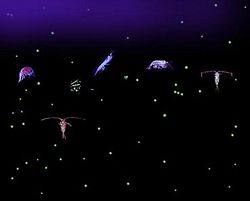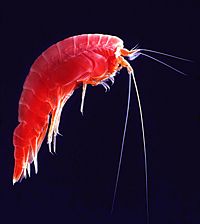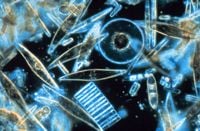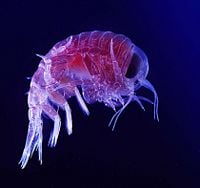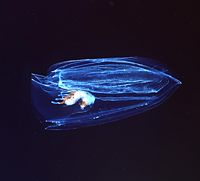Plankton
Note: This is only a rough draft, with notes. Please do not edit this article until the final draft is complete — i.e., when this notice is removed. You may add comments on what you would like to see included in the discussion area. Rick Swarts 23:18, 3 April 2006 (UTC)
Plankton are drifting organisms that inhabit the water column of oceans, seas, and bodies of fresh water.
Definitions
The name plankton is derived from the Greek term πλαγκτον, meaning "wanderer" or "drifter". While some forms of plankton are capable of independent movement and can swim up to several hundreds of metres vertically in a single day (a behavior called diel vertical migration), their horizontal position is primarily determined by currents in the body of water they inhabit. By definition, organisms classified as "plankton" are unable to resist ocean currents. This is in contrast to nekton organisms that can swim against the ambient flow of the water environment and control their horizontal position (e.g. squid, fish, krill and marine mammals).
Within the plankton itself, holoplankton are those organisms that spend their entire life cycle as part of the plankton (e.g. most algae, copepods, salps, and jellyfish). By contrast, meroplankton are those organisms that are only planktonic for part of their lives (usually the larval stage), and that graduate to either the nekton or a benthic existence. Examples of meroplankton include the larvae of sea urchins, starfish, crustaceans, marine worms, and most fish.
Plankton abundance and distribution are strongly dependent on factors such as ambient nutrients concentrations, the physical state of the water column, and the abundance of other plankton.
The study of plankton is termed planktology. Individual plankton are referred to as plankters.
Functional groups
Plankton are primarily divided into broad functional (or trophic level) groups:
- Phytoplankton (from Greek phyton, or plant), autotrophic pro- or eukaryotic algae that live near the water surface where there is sufficient light to support photosynthesis. Among the more important groups are the diatoms, cyanobacteria and dinoflagellates.
- Zooplankton (from Greek zoon, or animal), small protozoans or metazoans (e.g. crustaceans and other animals) that feed on other plankton. Some of the eggs and larvae of larger animals, such as fish, crustaceans, and annelids, are included here.
- Bacterioplankton, bacteria and archaea, which play an important role in remineralising organic material down the water column (note that many phytoplankton are also bacterioplankton).
This scheme divides the plankton community into broad producer, consumer and recycler groups. In reality, even the trophic level of some plankton is not straightforward. For example, although most dinoflagellates are either photosynthetic producers or heterotrophic consumers, many species are mixotrophic depending upon their circumstances.
Size groups
Plankton are also often described in terms of size. Usually the following divisions are used:
- Megaplankton, 2×10-1→2×100 m (20-200 cm)
- Macroplankton, 2×10-2→2×10-1 m (2-20 cm)
- Mesoplankton, 2×10-4→2×10-2 m (0.2 mm-2 cm)
- Microplankton, 2×10-5→2×10-4 m (20-200 μm)
- Nanoplankton, 2×10-6→2×10-5 m (2-20 μm)
- Picoplankton, 2×10-7→2×10-6 m (0.2-2 μm), mostly bacteria
- Femtoplankton, < 2×10-7 m, (< 0.2 μm), consisting of marine viruses
However, some of these terms may be used with very different boundaries, especially on the larger end of the scale. The existence and importance of nano- and even smaller plankton was only discovered during the 1980s, but they are thought to make up the largest proportion of all plankton in number and diversity.
Distribution
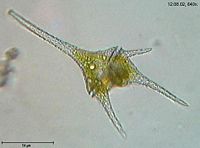
Plankton are found throughout the oceans, seas and lakes of Earth. However, the local abundance of plankton varies horizontally, vertically and seasonally. The primary source of this variability is the availability of light. All plankton ecosystems are driven by the input of solar energy (but see chemosynthesis), and this confines primary production to surface waters, and to geographical regions and seasons when light is abundant.
A secondary source of variability is that of nutrient availability. Although large areas of the tropical and sub-tropical oceans have abundant light, they experience relatively low primary production because of the poor availability of nutrients such as nitrate, phosphate and silicate. This is a product of large-scale ocean circulation and stratification of the water column. In such regions, primary production, still usually occurs at greater depth, although at a reduced level (because of reduced light).
Studies have shown that the mineral iron (but only in the proper amounts) leads to increased blooms of many (though not all) kinds of phytoplankton. Iron is primarily made available to oceanic phytoplankton through the deposition of atmospheric dust on the sea surface. Oceanic areas adjacent to arid parts of continents thus typically have abundant phytoplankton (e.g., the western Atlantic ocean, where trade winds bring dust from the Sahara Desert in north Africa). It seems a paradox that arid land areas may actually contribute to increased plant life proliferation in the world's oceans. It has been theorized (but never actually attempted) that large-scale 'seeding' of the world's oceans with iron would generate such massive blooms of phytoplankton so as to draw enough carbon dioxide out of the atmosphere to counteract the Greenhouse Effect (or global warming).
While plankton are found in the greatest abundance in surface waters, they occur throughout the water column. At depths where no primary production occurs, zooplankton and bacterioplankton instead make use of organic material sinking from the more productive surface waters above. This flux of sinking material can be especially high following the termination of spring blooms.
Biogeochemical significance
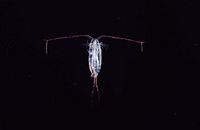
Aside from representing the bottom few levels of a food chain that leads up to commercially important fisheries, plankton ecosystems play a role in the biogeochemical cycles of many important elements. Of particular contemporary significance is their role in the ocean's carbon cycle.
As stated, phytoplankton fix carbon in sunlit surface waters via photosynthesis. Through (primarily) zooplankton grazing, this carbon enters the planktonic foodweb, where it is either respired to provide metabolic energy, or accumulates as biomass or detritus. As living or dead organic material is typically more dense than seawater it tends to sink, and in open ocean ecosystems away from the coasts this leads to the transport of carbon from surface waters to the deep. This process is known as the biological pump, and is one of the reasons that the oceans constitute the largest (active) pool of carbon on Earth.
Some researchers have even proposed that it might be possible to increase the ocean's uptake of carbon dioxide generated through human activities by increasing the production of plankton through fertilization, primarily with the micronutrient iron. However, it is debatable whether this technique is practical at a large scale, and some researchers have drawn attention to possible drawbacks such as ocean anoxia and resultant methanogenesis (caused by the excess production remineralising at depth).
Popular Culture
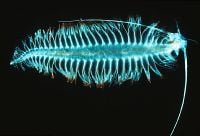
In the animated television series SpongeBob SquarePants, Sheldon J. Plankton is the name one of the primary antagonists SpongeBob faces. His relationship to plankton is manifested in his size, and he is much smaller than the other characters.
In an episode of the animated television series The Simpsons, the family chooses to go shopping at a 33-cent discount store which offers a variety of strange foods. Homer purchases and eats expired canned plankton, and consequently falls ill as a result of red tide poisoning.
The science fiction novels Timescape by Gregory Benford, and The Secret Of Life by Paul McAuley both invoke environmental disasters caused by changes in the ecological behaviour of plankton.
The Nintendo DS console has a videogame called Electroplankton in which they create music.
ReferencesISBN links support NWE through referral fees
- Omori, M. and Ikeda, T. (1992). Methods in Marine Zooplankton Ecology, Krieger Publishing Company, Malabar, USA.
See also
- Algal bloom
cs:Plankton da:Plankton de:Plankton es:Plancton eo:Planktono fr:Plancton ia:Plancton it:Plancton he:פלנקטון nl:Plankton ja:プランクトン no:Plankton pl:Plankton pt:Plâncton ru:Планктон fi:Plankton sv:Plankton vi:Sinh vật phù du uk:Планктон zh:浮游生物界
Credits
New World Encyclopedia writers and editors rewrote and completed the Wikipedia article in accordance with New World Encyclopedia standards. This article abides by terms of the Creative Commons CC-by-sa 3.0 License (CC-by-sa), which may be used and disseminated with proper attribution. Credit is due under the terms of this license that can reference both the New World Encyclopedia contributors and the selfless volunteer contributors of the Wikimedia Foundation. To cite this article click here for a list of acceptable citing formats.The history of earlier contributions by wikipedians is accessible to researchers here:
The history of this article since it was imported to New World Encyclopedia:
Note: Some restrictions may apply to use of individual images which are separately licensed.
